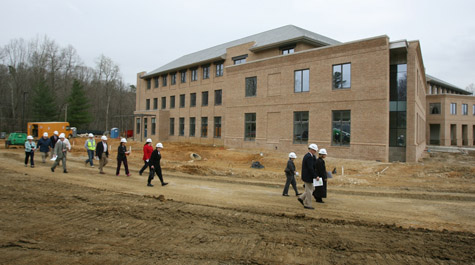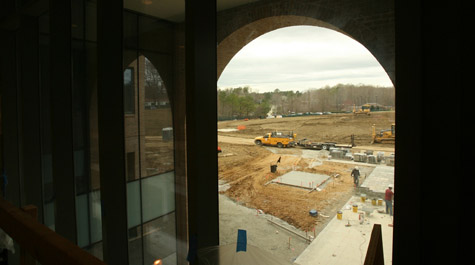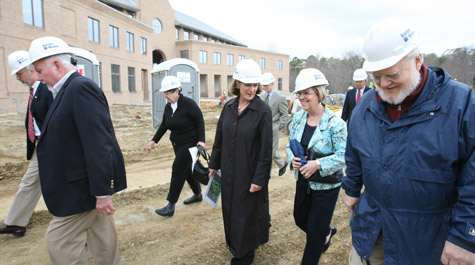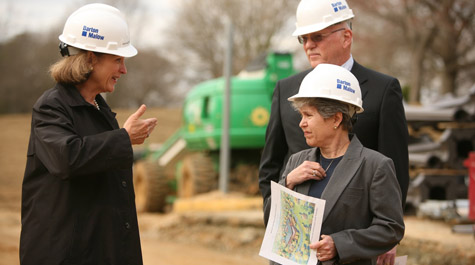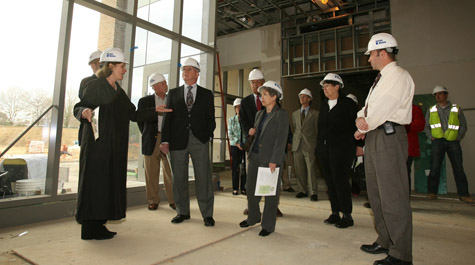New SOE building nears completion
"In this lobby, we will see everyone from infants to retirees," said Dean Virginia McLaughlin on a recent tour of the facility. "It will epitomize learning across the lifespan."
The $48 million project is expected to be completed in May 2010, with the dean's office and some of the school's centers moving in as early as May 17. The rest of the School of Education will relocate there in the beginning of June. In April 2008, the Virginia General Assembly approved a bond measure that provided William and Mary with $38 million to fully fund construction of the new building.
Located off of Monticello Avenue on the former site of the Sentara Williamsburg Community Hospital, the new building includes 113,000 square feet for classrooms, faculty offices, centers, professional development areas and more. The space will also house the Rita Welsh Adult Literacy for Life Program.
This will be the first time that the all of the School of Education's academic programs, centers and projects will be gathered in one location, including: The Center for Gifted Education, Historic Triangle Substance Abuse Coalition, Math & Science Partnership, New Horizons Family Counseling Center, Project HOPE-Virginia, School Leadership Institute & School-University Research Network, Special Education Training and Technical Assistance Center, and the STEM Education Alliance: Virginia Demonstration Project. Currently, the school is based out of 26,000 square feet in Jones Hall, with several of its centers and programs housed in five other locations around the Williamsburg area.
"The move is complicated in that we're not all coming from the same place," said McLaughlin. "But we'll all finally be under one roof."
The building includes a technology integration center, learning resource center and 14 classrooms, all equipped with the same level of technology that the most state-of-the-art classrooms on William & Mary's main campus now offer. A distance-learning classroom with tiered seating and several collaboration classrooms will offer even more technological options for students and professors.
Faculty offices are slightly larger than what they had before, and graduate students will work in cloverleaf-shaped pods in open areas. The offices were set up to promote "cross-fertilization" among the school's many faculty and staff members, said McLaughlin.
"We wanted to promote collaboration and sharing," she said.
The school's various centers and programs will also find themselves with much more room and spaces that are designed with their needs in mind. For instance, in what McLaughlin calls "the human services wing" of the building, the New Horizons Counseling Center now has a "real mental health facility." McLaughlin said that the building was also designed in such a way so that as programs expand and contract, the space will able to still accommodate them.
The facility's new professional development center will allow the school to host nearly all of its conferences, which reach 20,000 non-degree seeking students per year. The center, which includes a large conference area that can hold between 280 and 300 people, will be used about 60 percent of the time by the School of Education and the rest of the time by university and community partners.
"It will not only be of use to us, but also to the local and professional communities," said McLaughlin.
The school is expecting to also see a lot of traffic from members of the community who use such programs as Literacy for Life, the Center for Gifted Education and the New Horizons Counseling Center. The Christopher Wren Association, which offers opportunities for continued learning, will also use the space for some of its classes.
Along with its academic areas, the new facility will also include a coffee shop, a deck and patio, a locker room, lounge areas and lockers for students.
"We've never had a place for students to put their things," said McLaughlin.
About 417 parking spaces - including some for community visitors -- will be available at the site, and a well-lit walking path from the College's Recreation Center to the back of the building will be available.
McLaughlin said that they wanted the building to be "recognizable as a William & Mary building," and so they included design elements such as Flemish bond brickwork. However, they also added some modern elements to its design, such as lots of open spaces overlooking a large courtyard in the back. The building is also being LEED certified, and will likely earn its silver certification, said McLaughlin.
As the building nears completion, McLaughlin is looking forward to what is will do for the School of Education and all of those who benefit from it.
"It will create all kinds of opportunities and efficiencies that we've never had," she said.
 Skip to main content
Skip to main content

